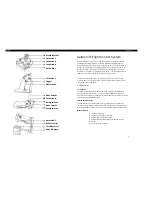
Page | 651
Scene:
A collection of INSTEON devices that react to and with one another in various ways.
Scenes are comprised of both Responders and Controllers. Scenes may be
initiated by an INSTEON event or by a Program.
Theme
: Several pre-defined ISY Administrative Console color schemes to available from
the
File
menu.
T
he Administrative Console must be closed and re-opened for the
Theme change to take effect.
Universal Plug and Play (UPnP):
A set of standards intended primarily for residential
networks to enable users to link their local and remote personal computers,
printers, Internet gateways, Wi-Fi access points and mobile devices to
seamlessly discover each other's presence on the network and establish
functional network services for data sharing, communications, and
entertainment.
Variable:
Program parameters that can be stored, modified using arithmetic operations,
and compared. You can use Variables to provide information, trigger programs,
etc. There are two different types of Variables: Integer and State. A State
Variable creates an event when it is modified, so it can be used to trigger ISY
Programs when it is currently or reaches a certain value. An Integer Variable is
not used to trigger a Program.
X10:
A protocol for communication among electronic devices used for home automation.
Developed in 1975, X10 was the first general purpose network technology to
allow remote control of home devices and appliances for residences. With new
components still available and millions of units in use worldwide, it remains
today’s most widely deploy
ed home automation protocol.
X10 primarily uses power line wiring for signaling and control. Each X10 switch
has a user-assigned address. The way X10 addresses are applied to switches
depends on type and manufacturer. X10 switches operate by responding to the
physical control (switch) on the device itself or by responding to a X10 control
signal addressed to that switch from an X10 signal source elsewhere in the
residence’s electrical system.
Typically, X10 devices are either controllers that generate X10 signals or light
switches or electrical sockets that respond to X10 signals. Controllers that are
only capable of generating X10 signals tend to have a somewhat utilitarian
appearance, so X10 signals are now often generated by Dual-Band devices such
as the KeypadLink controller, by a PDA via an IR/X10 protocol converter, or
better yet, by a program in the ISY.
Although, as a protocol, X10 lacks the capabilities and operational reliability of
INSTEON, X10 switches remain the preferred way to control devices that may
Summary of Contents for ISY-994i Series
Page 1: ...The ISY 994i Home Automation Cookbook ...
Page 35: ...Page 12 Figure 6 UDAjax Main Screen ...
Page 36: ...Page 13 Figure 7 UDAjax Devices Scenes Screen ...
Page 68: ...Page 45 Figure 44 NodeServer Configuration popup 5 2 5 Tools Menu Figure 45 Tools Menu ...
Page 102: ...Page 79 6 6 3 2Activate My OpenADR Portlet Figure 77 OpenADR My OpenADR Menu Option ...
Page 103: ...Page 80 6 6 3 3Configure OpenADR Settings Figure 78 OpenADR Settings Menu Option ...
Page 104: ...Page 81 Figure 79 OpenADR Settings Display ...
Page 108: ...Page 85 6 6 3 7Issue an Event Figure 84 OpenADR Issue and Event ...
Page 110: ...Page 87 Figure 86 OpenADR Event Viewer ...
Page 116: ...Page 93 Figure 92 ElkRP2 Account Details M1XEP Setup Button In the M1XEP Setup Window ...
Page 267: ...Page 244 Figure 189 State Variables ...
Page 268: ...Page 245 Figure 190 Programs and Folders ...
Page 292: ...Page 269 Figure 192 Irrigation Folders Figure 193 Irrigation Devices ...
Page 376: ...Page 353 Figure 209 Save Topology File ...
Page 433: ...Page 410 Figure 242 X 10 recognized as Living Room East Device ...
Page 540: ...Page 517 Figure 357 In Car Detection 12 Figure 358 In Car Detection 13 ...
Page 602: ...Page 579 Figure 382 SecureCRT SSH Raspberry PI Session ...
Page 685: ......
















































